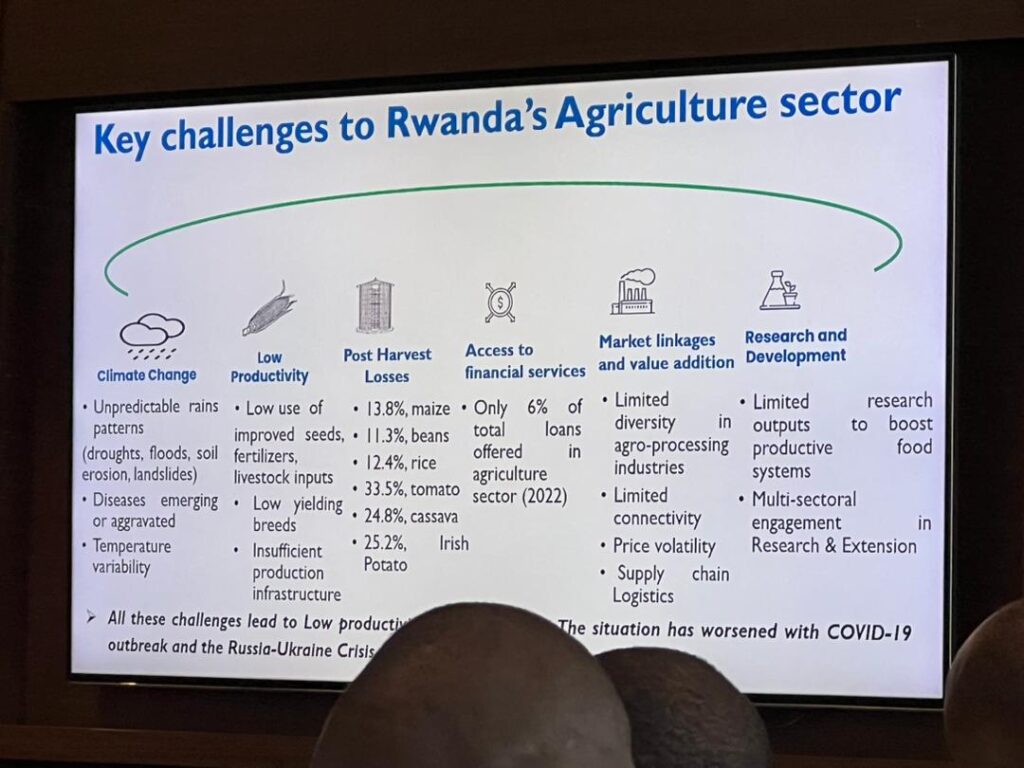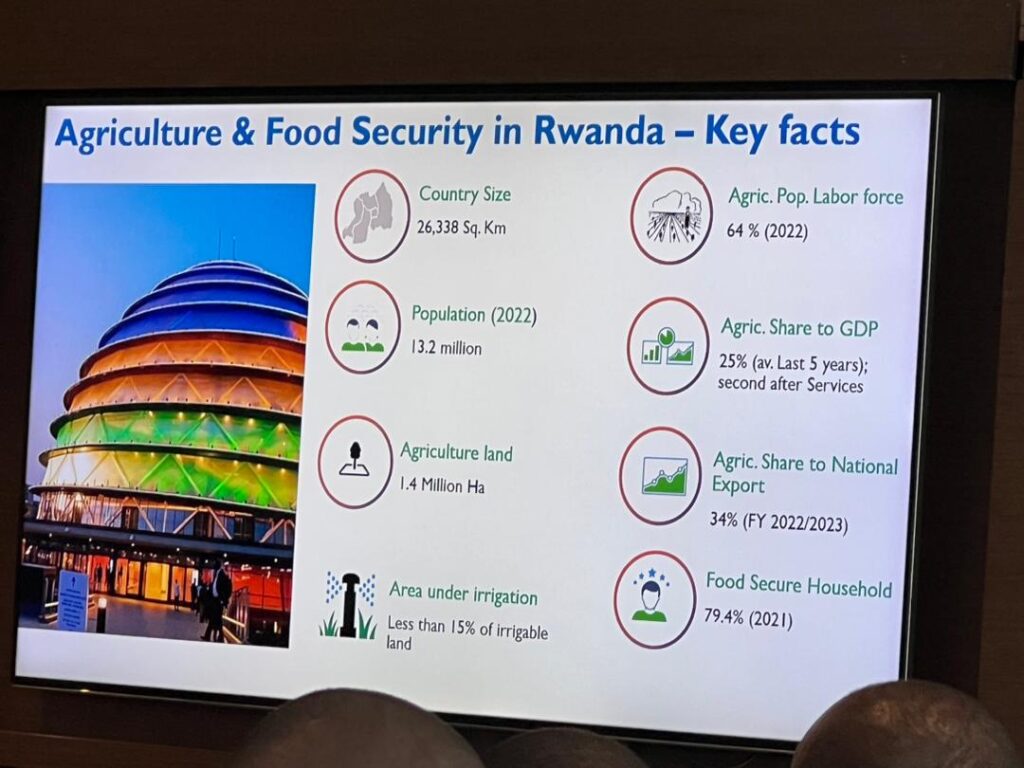By Annonciata Byukusenge
Maize, the third largest crop in Rwanda, is largely produced by smallholder farmers. Many farmers cultivated this crop to generate money and change their living conditions. In 2024 Term A, Maize production was at 600,000 Tons. The Ministry of Agriculture and Animal Resources states that Rwanda needs about 850,000 Tons per Term. On the other side, the Farmers say that they are afraid of Maize stalk borer and climate change effects which disturb maize farming and experience unstable production with many losses. The Government of Rwanda, after passing the Biosafety Law governing Genetically Modified Organism in February 2024, the Maize Farmers expect GMOs to be a solution.
Immaculée Mukamana wakes up at 5 Am every day. Her main activity consists of maize farming in a large 10-hectare farm at Rukira, a remote rural village in the Huye district in Southern Rwanda.
The 42-year-old mother never envisioned that her efforts in the farmlands would pave the way for women workers in her remote village to pursue prosperous lives.
“Women are now playing a vital role in agriculture, contributing to current national efforts towards improving maize production, unfortunately, the Maize stalk borer (locally known as Nkongwa) is a challenge for maize farmers, and we fall in many losses many times,’’ she said.
Mukamana is a maize farmer in Kumusizi swamp, Rukira cell, Huye sector in Huye sector. With other farmers in this swamp, they formed a cooperative named Koperative Jyambere Muhinzi wa Huye /KOJYAMUHU).

In this swamp, they farm maize, rice, and vegetables. The farmers who have a serious problem are maize farmers. Those farmers say that they counted a loss caused by the Maize stalk borer for three years.
“One kilogram of seeds is 1000Rwf. The 10-ha cost more than 100 kg of maize. When maize is still young, the Maize stalk borer starts to destroy them. It starts by attaching leaves and trees, and then maize can’t make grains at all.”
She added that they learned about Genetically Modified Crops (GMOs), and found that GMO crops can fight against Maize stalk borer, don’t need more fertilizers, and resist drought and more rainfall.
“The challenge we have is that old seeds can’t resist the impact of climate change. In the dry season the seeds we plant dry immediately. If possible, accessing the GMOs will be a solution for us. We buy seeds, and fertilizers at a high cost. But finally, we don’t get benefits because of those challenges mentioned above. If we start cultivating GMO maize, we will farm in each season because those seeds will require a great cost, but other good news is that they will resist climate change.”

According to Francoise Mukeshimana, a maize farmer in Nyagatare district, Karama sector, the sustainable solution to the Maize stalk borer, is to find seeds that resist Maize stalk borer and famine because they plant seeds can’t resist it.

Jacqueline Mukanoheli and Théogène Habamenshi, are maize farmers in the Gatsibo district, Ngarama sector in Kabeho village. In an interview with Forefront Magazine, those farmers say that the maize production is gradually reducing because the seeds they plant don’t resist drought.

They said: “In Eastern Rwanda, we have a problem of drought caused by the impact of climate change, because the sun season takes a longer time than normal time, many years ago. We need seeds that can resist drought and the impact of climate change because nowadays the season has already changed.”
Dr Athanase Nduwumuremyi is a Coordinator of the Roots & Tubers Program/ Senior Research Fellow & Cassava breeder at Rwanda Agriculture Board (RAB),
He highlights the importance of Genetically Modified Crops and technology in the agriculture sector and how it will resolve food security issues.
“GMO maize varieties especially Bt maize (TELA maize) are resistant to stem borer and fall armyworm (Nkongwa). Also, there are some genetically improved maize seeds resistant to drought and insects like what is locally known as (Nkongwa).”
He added that the crops like maize transformed through technology will be distributed to the farmers after confirmation of using biotechnology in Rwanda. Those GMO (Genetically Modified Organism) crops also resist the impacts of climate change, because climate change also contributes to the food security issues.”

Rwanda’s Crop Intensification Program (CIP) is primarily a land consolidation program aimed at improving agricultural productivity and food security. The program, which began in 2007, focuses on mono-cropping and commercialization of six priority crops: maize, wheat, rice, white potato, beans, and cassava.
In May 2024, Director General Rwanda Agriculture and Animal Resources Development Board (RAB) Dr Telesphore Ndabamenye said that technology through genetically modified crops is needed in agriculture because it will help in coping with food security issues in Rwanda.
“To have food requires to have technology. We are working on the cassava crops and we hope that technology will help us to make a difference in our agriculture as it helps in other sectors.”

White maize in South Africa is the only staple crop produced using GM seeds. The GM white maize has resulted in 4.6 million additional rations annually. From 2001 to 2018, estimated GM white maize welfare benefits amounted to $695 million. From 2001 to 2018, estimated GM white maize ecosystem benefits amounted to $5 million. Nowadays, GM seeds are more profitable than non-GM seeds in the Free State and North West in South Africa. This indicates that GM Maize also can be a solution for Maize Farmers in Rwanda.
Recently, Italian researchers published a review of studies concluding planting genetically modified (GM) maize (corn) over the past 20 years has increased the agricultural yield of this popular and important staple food. They allow better control of problematic weeds and facilitate the adoption of more environmentally friendly phytosanitary products, as well as sustainable no-till farming practices. The reduction of losses by pests, viruses, and weeds that compete for soil nutrients, together with savings in phytosanitary products and fuel, indirectly increases the final yield when compared with conventional crops.

These advantages were previously documented in two major academic reviews by agricultural economists. The first, which was published in 2014 and included a review of 147 studies, concluded that GM crops have allowed an average increase in agricultural yield by 22 percent and increased farmers’ profits by 68 percent, with profit margins even larger in developing countries.
The review published in 2017, indicated that between 1996 and 2015, GM crops increased global production by 357.7 million tons of maize. 25 years ago, GM crops increased production to 595 million tons of maize.
In 2022, the African region accounted for the highest level of hunger as described by the Global Hunger Index. According to the World Health Organization, over 340 million Africans were undernourished and severely food insecure between 2014-2020. Research into the value gained from planting GM crops has shown that 65% of the gain came from higher yield and production and 35% from lower costs.

Status of Law Governing Biosafety
* Biosafety Law was published
* Ongoing elaboration of implementing orders: Prime Minister’s Order and a Ministerial Orders
* Biosafety Law purpose: The law establishes an adequate level of protection in the field of the safe transfer and use of living-modified organisms, resulting from modern biotechnology that may hurt the conservation and sustainable use of biological diversity while taking into consideration the impact of the transfer and use on human health
* Scope of the Biosafety Law: The law applies to the transboundary movement, transit, and use of all living modified organisms through modern biotechnology, that may have adverse effects on the conservation and sustainable use of biological diversity and risks to human health. However, living modified organisms that are pharmaceuticals for human use are not governed by this law.
Policies And Regulations in Rwanda
The Government of Rwanda introduced different policies and regulations for the safety of food and Drugs.
Highlights:
* National Agriculture Policy: Supports research on agricultural biotechnology
* National Science, Technology, and Innovation Policy;
“Promote research in new and emerging technologies: formation of research clusters in S&T fields including artificial intelligence, space, cyber security, e-commerce, digital health, biotechnology, nanotechnology, quantum sciences, neurosciences, genetic engineering, internet of things, big data, quantum technologies, photonics, nuclear sciences, and precision agriculture”.
* Presence of Rwanda Environmental Management Authority (REMA)
* Presence of Rwanda Inspectorate, Competition and Consumer Protection Authority (RICA)
* Presence of Rwanda Food and Drug Authority (RFDA)

